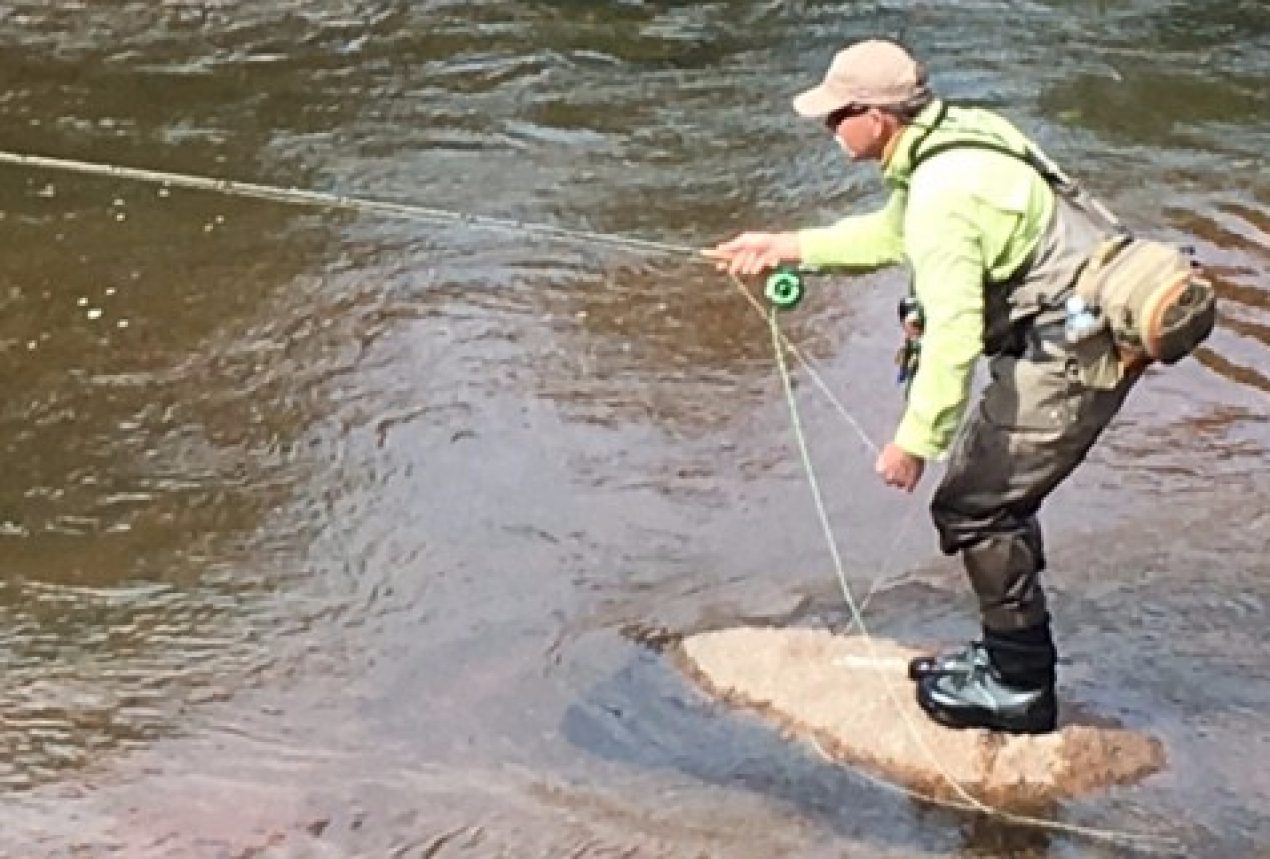Archive for the ‘fly fishing’ Tag

Hidy Ho good neighbors! Obstructions, obstructions, fish the obstructions. First off, what are obstructions, and secondly, how should I fish them?
Looking at the picture above, gives a clear impression of what an obstruction is. To me, it’s any thing (or person, in this case) that affords a respite for fish from current in moving water. Be it natural, or man-made, it provides protection, safety, comfort, food, and sometimes additional oxygen. If an obstruction protrudes beyond the water surface, and the flow is strong, it can actually mix oxygen into the water.
So we have a cursory idea of obstructions. Now, how should we fish them? Countless times I’ll set a client in a run slot, and watch as the indicator bumps or stops in the same place drift after drift. The first couple of bumps and the angler usually will set, and typically after that I’ll hear, “There must be something down there I keep snagging on”. Exactly! It’s an obstruction! Use it to your advantage!
If you’re blind nymphing, meaning nymphing a run where you can’t spot fish, and can’t see bottom, then finding an obstruction is a gift from the fly fishing gods. We know that fish will sit in front, behind, or to either side of an obstruction according to river flow dynamics. Again, armed with this information, attack the obstruction. But how?
Move your feet. If you know where your bumping the obstuction, the amount of line you have out, and the general angle of your casts, then simply move your feet to change attack angles. A step back usually allows you to fish the near side of the obstruction. Stepping upstream with a quarter step in, usually gets you to the front of the obstruction. So forth and so on.
I harp all of the time about miniscule changes in positioning, and continue to this day to be amazed at the BIG differences caused by subtle position changes. I harp on this so much during trips that last week, a great guy named Bill was releasing a fish from his knees. After release, the trout slid tight downstream of him to sit in the soft water and recuperate. Bill looked up at me and said, “I am an obstruction”.
Fish those obstructions, buy The Flyfishers Playbook for Father’s Day, and Fear No Water!
Duane
Hidy ho good flyfishers.
A River Runs Through It was a great movie, no doubt. It did wonderful marketing and spurred the fly fishing industry. Fantastic acting, scenery, and of course the epic fly casting. Ah, the fly casting. Proved to be the strike point or brand of the film. However, I think it has scared away many would be fly fishers.
I have folks come into the fly shop and tell me that they would love to learn to fly fish but aren’t capable of the rod handling that they saw in the movie. Had a nice lady ask me last year if she should book back to back days on the water, because she figured we would work the entire first day on casting. My clients today said I better think about just tying on one fly (instead of three) because they aren’t capable of casting three fly rigs. I told them that if you can say “three bug rig” you can certainly cast it.
I admire good casting skills as much as the next dude, but all an nymph angler needs is the ability to utilize a water loaded roll cast. Stick your elbow in the slot, get your thumb as high as your hat, pick a spot, and put your thumb on it. It really is that simple, and I find folks pick it up rapidly. And yup, you guessed it, the minute you roll cast you are officially fly fishing. I have a video or two on youtube dealing with casting. They are easy to find, if you want a refresher. Just type my name and youtube for a search.
The South Platte is fishing great. Blue Wings are coming off any time of the day depending on conditions, and the fish are on them. Trips have been very productive nymphing in the morning and looking for noses to cast dry flies and dry-drops to in the late morning, early afternoon. Pheasant tails and baetis emergers are the ticket.
I am busy working on a new technique, nothing earth shattering, but it works. I’m having clients utilize it in certain conditions, and it is proving to be effective and fun. Think I’ll keep R&Ding it and maybe include it in my next book. Time will tell.
Probably going to post every other week, because I’m getting very busy. If something happens that just needs to be shared, I’ll certainly post it. Please feel free to contact me, and comment. Until then, Fear No Water! Duane
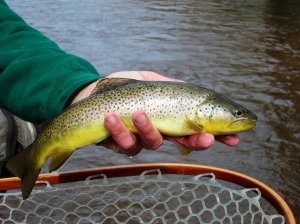
So, I’m trying to get some sight fishing video last weekend before a guiding trip and I run into this nutty fish. I watch this trout slide up the edge of the rock-to- sand line, witness him stage-up and proceeded to prepare the attempt.
The South Platte below Deckers, Colorado is unique, in that, it has an inordinate amount of sand. Decompossing granite actually, left over from erosion deposits after the Hayman Fire. Those that fish it regularly know that when fish set up on the rock to sand edge, they are there to eat.
I get the camera set on a tripod, strip out the line I need, and the rest is history. I rolled that fish. He ate hard, I set, and on his intial move the bug came unbuttoned. Usually, at that point the fish will disolve over the rocks, or slide downstream to the nearest pool to pout. After watching this fish react for an instant it became obvious the he was not going to flush.
If you watch closely, I change my angle slightly, to change the drift characteristics a bit. A subtle change in angles can make the difference. I also move closer to this fish, and a bit more behind him. Make the appropriate moves and fish with confidence.
Once the depth and speed are dialed in, little changes in angles can illicit even pricked fish to eat again. It’s unusual, but like I have said before, trout are funny people.
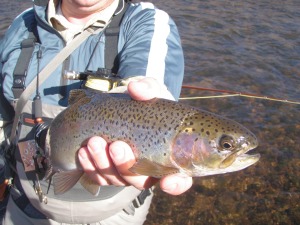
Here’s a nice rainbow that ate for my client later that day. Only had to prick her once!
To see the video of the twice-pricked fish, go to:
http://youtu.be/_Vm0pUXd3u0
Hope you enjoy, and Fear No Water!
Duane
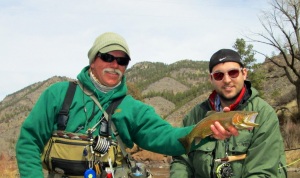
During the winter, I’m not on the water as much as when the season is ripping. That being said, when I do have gaps between trips, it sometimes feels as if I am guiding on “new” water.
About a month ago I guided on a stretch of water that I hadn’t laid eyes on in two years. To say I was a bit aprehensive would be more than accurate. But, over the years I’ve learned a few tricks that ease the pain and usually gets us into fish in a reasonable time frame.
First off, no matter the size of the river, learn to break it down into “runs” in longitudinal sections. River left, river middle, and river right. I learned that reading Bill Edringtons’ book about the Arkansas River. This will help you manage the river and your emotions. Just pick it apart from down-to-up and in-to-out. By this, I mean to pick one run in one section, and fish it up river from near to far.
Fish to your strengths. I’m fairly adequate at nymph fishing, so I am absolutely going to dial in depth and speed. You can catch fish with the wrong bugs at perfect depth and speed. Once I do a bit of reverse-engineering, or recognizing adult bugs and working back to the nymph stage, I should be picking up increasing numbers of fish because of the right fly choices. If you’re good and confident at throwing streamers, dry-drops, or whatever, use it to your advantage to pick up fish while you learn more about the river.
Apply what you know. For example, if you know how, where, and why fish set-up around an obstruction or in a bend, then concentrate on that water. If you’re proficient in riffles, then find and fish them. What you know breeds confidence and allows you to systematically attack the river. No guesses, only the next option. Enjoy the experience.
Make sure you can identify caddis, mayflies, midges, and stone flies. Learn their stages, and simple flies that mimic them.
Last and certainly not least, employ fish spotting skills. I am a much better guide and fly fisher when I can see fish. No big mystery there, but good polarized optics and the accompanying skills are paramount.
Just a few thoughts on using old tricks on a new river. Try it sometime and Fear No Water!
Duane
Here we sit on the edge of Spring. Sure, it’s officially spring, but don’t try to tell that to our rivers. To the South Platte, it’s still winter fishing conditions; however, and this is a big however, the aquatic life is starting to get the itch.
Soon, we will begin to hit arguably my favorite time of the year for fly fishing. Historical hatches will start to come off, and the fish (rainbows), coming out of winter, will begin to spawn and eat. Fish will set up in the riffles at a chance to hammer food as it quickly zips by. When not in the riffs you’ll find them in food super hiways sweeping side to side. To capitalize, you must stay ahead of the hatch.
I’m not talking simply about identyfing adult bugs and reverse engineering, I’m talking about catching fish now on what is about to hatch. Anyone can properly determine which stage of which bug to fish if he or she sees the adults. On my last trip, I counted one Blue Wing (BW) actually bouncing about as an adult. Interestingly, we caught roughly 9 out of every 10 fish on a BW nymph, because I know that the BW’s are getting close to the historical time that they begin to hatch.
My assumptions mean that not only are the bugs looking to hatch soon, but the fish are also beginning to look for that bug to get active. Whether it’s water temperatures, sun angles or pre-spawn activity, something is turning the fish onto the nymph stage of an expected hatch. Use it to your benefit, and stay ahead of the hatch. A size 20 Mercury Pheasant Tail was the ticket.
What about when the daily BW hatch hits, how do you stay ahead of that? Most days you have a pretty good idea when the daily hatch will occur. There are exceptions, especially on tailwaters, because of water levels, water temperatures, and weather conditions. All of that aside, the bugs will hatch sometime, somewhere, on the river. You just have to be prepared.
I usually will begin the day nymphing with an emerger and nymph representation of what I expect to come off. When I see the first adult, wham, I am switching to a couple emerger patterns below an attractor. For the sake of brevity, if you know the life cycle of the mayfly, you can decide when to throw a nymph, emerger, dun, spinner, or spent. Same goes for caddis, stone flies and midges. Learn the life-cyle, be prepared, and stay ahead of the hatch.
Couple thoughts on stone flies and caddis. The last couple weeks, I have been picking up fish with stone fly nymphs. Not because they are getting ready to hatch, but because they are molting. Basically, they are shedding into larger skeletons and the “new” nymph is quite yellow. Hence, we’re picking up fish on nymph representations that are yellow. As for caddis (and midges too), they progress from nymphs to pupa. Learning to fish the pupae patterns at the proper time can reap huge benefits even in the middle of a huge hatch.
The more you know about life-cycles and fish behavior the better. I go into this subject in much more detail in The Fly Fishers’ Playbook. For now, work to stay ahead of the hatch.
 Here’s Mandy from last week. We fished ahead of the hatch and picked up this beauty on a size 20 Mercury Pheasant Tail (Blue Wing nymph).
Fear No Water,
Duane
Here’s Mandy from last week. We fished ahead of the hatch and picked up this beauty on a size 20 Mercury Pheasant Tail (Blue Wing nymph).
Fear No Water,
Duane
Hidy Ho good neighbors,
Little tardy with the post this week. This time of year gets tough, in that, I am combining fly fishing, upland game, and speaking engagements into a 24 hour day. Not complaining, but I will be happy when guiding pheasant hunts is over the end of this month. By the way, I guide on a private ranch, so seasons are longer than public stuff.
Had a couple great fly fishing trips last week. The fishing has been good. I really focused last week on working the angles with my clients. By that I mean we worked runs effectively and efficiently utilizing typical depth, speed, profile, and color principles (D,S,P,C), but added in angles.
All else being equal, a slight variation in a casting angle can change the presentation just enough to illicit a fish-eat. It’s the next step in becoming a good nymph fly fisher. The ability to pick or squeeze out the last bit of fish holding water can make all the difference in the world in the number of hook-ups.
Let’s say you’re fishing a run, have the D,S,P,C dialed in and feel as if you’ve picked the run apart perfectly. Before you walk away, try to change angles. I suggest subtle movements, left, right, forward, back, or a combination of those to fully cover the water. You may have prefectly drifted a seam, but missed a feeding fish by mere inches. Maybe the fish is swinging 6″ right and left, and you are drifting just outside that zone. Since, you can’t be exactly sure where your bugs are throughout the entire drift, a simple angle change can make the difference. Folks that fish with me will attest to this, it is amazing how many fish we pick up after a subtle angle change. “If you change nothing, nothing changes”.
Also, I see clients continue to pound the same part of a seam, and every time they are hooking up on the same obstruction. A subtle change will get you past that obstruction, and because of how fish hold around obstructions, it’s not unusual to catch a fish after an angle change by that very obstruction that was “in the way”.
In the picture I am posting about how to attack a bend, really look it over as to how to cover the bend completely. What is left out is how to finish each stage by subtle angle changes, before moving to the next stage. Just too hard to show graphically. Look at it this way, after you’ve finished a stage, use your intuition to dictate to you what angle change is necessary to completely cover the run. Sounds silly, but it works.
The longer you nymph fish with the same set-up, the more “intuitive” you become. You begin to “see” your bugs underwater, and realize the angle change to finish the run. It’s called angling for a reason.
I explain this concept further in The Playbook, and will sometime post a video. You may not catch fish in each run, but I promise you’ll walk away from it knowing you fished it well. For now, Fear No Water! Thanks for dialing in.
Duane


Hey Folks,
Here’s a bow we hooked last week on a Pat’s Rubber Leg. The Stone Fly nymphs are molting, and the fish are on them.
Last week I was priveledged to speak to another Trout Unlimited Chapter. The Cheyenne Mountain Chapter out of Colorado Springs is a very innovative and energetic group. I look forward to tracking their progress.
Next week, the 14th, I will be speaking to the Greenback Chapter of TU in Pueblo. Road trip! It is very humbling to stand in front of hard working, dedicated folks, and talk fly fishing. My presentation deals with the restoration of Horse Creek, all the factors that negatively effect the Platte, and how to overcome them. The ol South Platte is hard enough to guide day in and day out, but you factor in how Horse Creek impacts it, and you are staring a super finicky beast in the kisser.
That’s how The Fly Fishers Playbook was born. It took a solid 5 years to develop the Playbook, and truth be told, it’s still evolving. The Playbook was basically written before I ever hit a key. I kept a journal for every minute I spent on that river. After a couple years I began to see that I could systematically progress thru options to get to fish. In other words, I stopped guessing as to what to do next, and began to filter thru the next best method to attack the river. It was a blast to write.
Why am I writing about this? I started writing the book 2 years ago March 5th, so I’m feeling a bit nostalgic. Also, the book has opened several doors. I’ve met some fantastic people presenting, doing book signings, podcasts, and of course on the river.
I’m really considering beginning another book. I’ve an outline cooking, but need to work out some details. In the meantime, I’ll continue to speak to whatever group that will have me.
Thanks for listening to my ramblings. Here’s another picture as payment….

Fear No Water,
Duane
Hey Folks,
Thought I’d continue with the theme from a couple weeks ago dealing with mending tecniques. I dug up an old short video dealing with an upstream cast and an upstream mending technique. This works for nymphing as well as dry fly work.
Being able to effectively pick apart a river while working upstream is invaluable. I like to work right up the middle of the river picking apart various seams from the inside out. You can cover, and I mean cover, serious water perfectly once this tecnique is mastered.
I absolutely live for the late afternoon after a full day guide trip when I get to fish my way home. Typically, I will throw a dry or two on and work as I described above. Great fun.
The key is to regulate the drift with the fly line loop that forms right under your rod tip. Strip line too fast and the loop is gone while you “pull” the flies thru the drift. Strip too slowly and the loop grows too big and the flies are dragged thru the water. Obviously, the better you control the loop by using the management loop, the more perfect the loop, and the more perfect the drift. It’s something you have to practice, but you can tell when the drift suffers.
Another thing, after the cast, leave the fly rod in the flat and low position. All too often I see folks upstream cast, and immediately lift the fly rod tip. Remember, the mend is the action of stipping in line at the proper speed.
Have fun with it. See the video at: http://youtu.be/QL4Tf56IF0I

Fear No Water!
Duane
Hey Folks,
The South Platte is being a bit cranky this week with a lot of shelf, anchor and sheet ice. I stayed off it this week, but thankfully added another day guiding pheasant hunters. Won’t be long before we start seeing the “big midge”, then Blue Wings, then Caddis.
Can’t wait. With good weather, plentiful bugs and good flows comes anglers. Not just any anglers, all anglers. The hard core guys will simply transisition from less crowds and skinny water, to hordes of river users and run-off. We’ve all done it before. Preachin’ to the choir.
Since we are all using the same hymnal, I gotta ask a favor. Can we all make an effort to educate those around us on river ettiquette? Anglers, guides, tubers, waders, kayakers, everyone needs to practice better ettiquette.
I can’t begin to tell you how often I get high or low holed, pinched or proded to leave a run. I also see anglers and other guide services setting up shop in one run all day. Do that for a couple days in a row and it destroys the run. I watched that happen all last year. People catching the same fish twice, foul hooking on purpose, poaching, walking through runs after they fish it, smashing redds, leaving crap on willows (flies, tippet), trash, I could whine about it all evening. I know you folks are adding to my list. Thing is, we all see it, we can all do something about it.
Last fall, being careful to not throw my shadow on the water above a fly fisherman, I politely asked him which direction he planned to fish the river. He responded, “Right here.” Ok, I looked at my clients, mustered the politness up again, and said, “I understand, we are trying to determine which way you plan to fish so we give you plenty of room. He said, “Right here.” “Suit yourself”, I said as we walked down stream to my favorite run and proceeded to whack fish below this guy. Had he a hair of sense he would have overcome his arrogance and locked up the run he was in and the one below.
I try to give folks the entire run they’re in the straight above or below it (if I can discern which way they are going), and the next bend. It’s river dependent, but that’s what I try to do. I (and other guides I know) will do our best to rotate through runs, it’s not unusual to bypass a small seam or two every now and then to try to give the fish a break. It’s common sense.
To promote common sense it starts with education, and it begins with us. A few things to remind other anglers about are:
- Proper fish handling (rubberized net, wet hands, quick, pinch barbs)
- Pictures (quick, no gills, don’t put them on rocks,snow,ice,grass,etc)
- Watch released fish swim away
- Try to keep tangled leader, tippet, etc
- Pack it out
- Give folks a smile, and some damn room
- Don’t cut-off,pinch, or high/low hole
- Don’t “camp” in a run
- Stay off redds
- Don’t disturb fish habitat
- Report poachers
- Calm down, fly fishing is fun
Feel free to add some of your own, I’m sure I’ve missed something. At the end of the day, we need to educate others on proper ettiquette, because nobody else is.
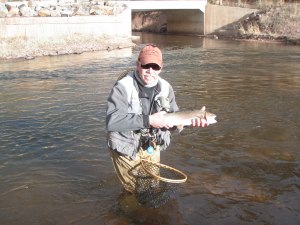 If you get bored the next time the snow flies, check out my videos on youtube. Just google search my name and youtube. As always, let me know what you think, and share this with your friends!
If you get bored the next time the snow flies, check out my videos on youtube. Just google search my name and youtube. As always, let me know what you think, and share this with your friends!
Fear No Water!
Duane
Hey folks!
I’ve been super busy running my shorthairs after game birds. I did, however find the time last week to put together a video dealing with the roll cast. The roll cast is a vital cast to master, because it forms a solid base of which to perfect other casts (reach, tuck casts).
I would guess that when nymphing I probably roll cast eighty percent of the time. It’s a great idea to be able to “spot cast” with a roll cast when nymphing to not only get onto fish accurately, but to also cut down on the amount of wind knots from casting a weighted nymph rig. When fishing dries, dry drops, and streamers, I will still use it to set up other casts and to minize fly-rod flash that spooks fish. It’s just a great tool.
At the end of the swing stage in a typical nymph drift, we always put in a blind or position set. If done correctly this actually leads perfectly into the first phase of the roll cast. All this stuff meshes together to make you one fly fishing machine.
See the video at: http://youtu.be/-y6Wo6XsAC4
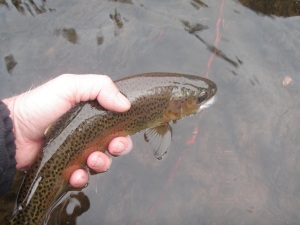
Feel free to comment and share it!
Fear No Water!
Duane
lonearcherguideservice@yahoo.com
